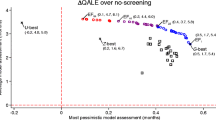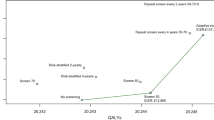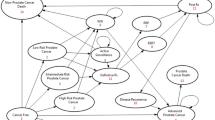Abstract
We describe a simulation optimization method to design PSA screening policies based on expected quality adjusted life years (QALYs). Our method integrates a simulation model in a genetic algorithm which uses a probabilistic method for selection of the best policy. We present computational results about the efficiency of our algorithm. The best policy generated by our algorithm is compared to previously recommended screening policies. Using the policies determined by our model, we present evidence that patients should be screened more aggressively but for a shorter length of time than previously published guidelines recommend.









Similar content being viewed by others
References
American Cancer Society (2010) NCCN guidelines for patients: prostate cancer. http://www.cancer.org/Cancer/ProstateCancer/MoreInformation/ProstateCancerEarlyDetection/prostate-cancer-early-detection-acs-recommendations
American Urological Association (2000) American Urological Association Prostate-specific antigen (PSA) best practice policy. Oncology 14:277–280
Andriole GL (2009) Mortality results from a randomized prostate-cancer screening trial. N Engl J Med 360(13):1310–1319
Arias E (2006) United states life tables. Natl Vital Stat Rep 58(21):1–40
Ashley RA, Inman BA, Routh JC, Mynderse LA, Gettman MT, Blute ML (2008) Reassessing the diagnostic yield of saturation biopsy of the prostate. Eur Urol 53(5):976–981
Aus G, Robinson D, Rosell J, Sandblom G, Varenhorst E (2006) Survival in prostate carcinoma-outcomes from a prospective, population-based cohort of 8887 men with up to 15 years of follow-up: results from three countries in the population-based national prostate cancer registry in Sweden. Cancer 103(5):943–951
Baluja S, Caruana R (1995) Removing the genetics from the standard genetic algorithm. In: Kuhl ME, Steiger NM, Armstrong FB, Joines JA (eds) Proceedings of the twelfth international conference on machine learning
Bastian PJ, Mangold LA, Epstein JI, Partin AW (2004) Characteristics of insignificant clinical T1c prostate tumors. A contemporary analysis. Cancer 101(9):2001–2005
Bremner KE (2007) Chong CAKY, Tomlinson G, Alibhai SMH, Krahn MD A review and meta-analysis of prostate cancer utilities. Med Decis Mak 27:288–298
Bubendorf L, Schöpfer A, Wagner U, Sauter G, Moch H, Willi N, Gasser TC, Mihatsch MJ (2000) Metastatic patterns of prostate cancer: an autopsy study of 1589 patients. Human Pathol 31(5):578–583
Buchholz P, Thümmler A (2005) Enhancing evolutionary algorithms with statistical selection procedures for simulation optimization. In: Kuhl ME, Steiger NM, Armstrong FB, Joines JA (eds) Proceedings of the 2005 winter simulation conference, pp 842–852
Chen C-H (1996) A lower bound for the correct subset-selection probability and its application to discrete-event system simulations. IEEE Trans Automat Contr 41(8):1227–1231
Chen EJ, Lee LH (2009) A multi-objective selection procedure of determining a pareto set. Comput Oper Res 36:1872–1879
Chhatwal J, Alagoz O, Burnside ES (2010) Optimal breast biopsy decision-making based on mammographic features and demographic factors. Oper Res 58(6):1577–1591
Chon CH, Lai FC, McNeal JE, Presti JC (2002) Use of extended systematic sampling in patients with a prior negative prostate needle biopsy. J Urol 167(6):2457–2460
Deb K, Agrawal S, Pratap A, Meyarivan T (2000) A fast elitist non-dominated sorting genetic algorithm for multi-objective optimization: NSGA-II. In: Schoenauer M, Deb K, Rudolph G, Yao X, Lutton E, Merelo J, Schwefel H-P (eds) Parallel problem solving from nature PPSN VI. Lecture notes in computer science, vol 1917. Springer, Berlin, pp 849–858
Djavan B, Margreiter M (2007) Biopsy standards for detection of prostate cancer. World J Urol 25:11–17
Vieweg J, Djulbegovic B, Dahm P (2010) Screening for prostate cancer: systematic review and meta-analysis of randomised controlled trials. BMJ 341:9. doi:10.1136/bmj.c4543
Draisma G, Boer R, Otto SJ, van der Cruijsen IW, Damhuis RAM, Schröder FH, de Koning HJ (2003) Lead times and overdetection due to prostate-specific antigen screening: estimates from the european randomized study of screening for prostate cancer. J Natl Cancer Inst 95(12):868–878
Dudewicz EJ, Dalal SR (1975) Allocation of observations in ranking and selection with unequal variances. Indian J Stat 37(1):28–78
Epstein JI, Sanderson H, Carter HB, Scharfstein DO (2005) Utility of saturation biopsy to predict insignificant cancer at radical prostatectomy. Urology 66(2):356–360
Eskandari H, Rabelo L, Mollaghasemi M (2005) Multiobjective simulation optimization using an enhanced genetic algorithm. In: Proceedings of the 37th conference on winter simulation. Winter simulation conference, pp 833–841
Etzioni RB, Cha R, Cowen ME (1999) Serial prostate specific antigen screening for prostate cancer: a computer model evaluates competing strategies. J Urol 162:741–748
Etzioni RB, Gulati R, Falcon S, Penson DF (2008) Impact of PSA screening on the incidence of advanced stage prostate cancer in the united states: a surveillance modeling approach. Med Decis Mak 28(3):323–331
Ferrini R, Woolf SH (1998) American college of preventive medicine practice policy: screening for prostate cancer in American men. Am J Prev Med 15(1):81–84
Fu MC (2002) Optimization for simulation: theory vs. practice. INFORMS J Comput 14(3):192–215
Ghani KR, Grigor K, Tulloch DN, Bollina PR, McNeill SA (2005) Trends in reporting Gleason score 1991 to 2001: changes in the pathologist’s practice. Eur Urol 47(2):196–201
Gold MR, Stevenson D, Fryback DG (2002) HALYs and QALYs and DALYs, oh my: similarities and differences in summary measures of population health. Annu Rev Public Health 23:115–134
Goldsman D, Nelson BJ (1994) Ranking, selection and multiple comparisons in computer simulation. In: Proceedings of the 1994 winter simulation conference. Winter simulation conference
Gustafsson L, Adami HO (2008) Optimization of cervical cancer screening. Cancer Causes Control 3(2):125–136
Haas GP, Delongchamps NB, Jones RF, Chandan V, Serio AM, Vickers AJ, Jumbelic M, Threatte G, Korets R, Lilja H, de la Roza G (2007) Needle biopsies on autopsy prostates: sensitivity of cancer detection based on true prevalence. J Natl Cancer Inst 99(19):1484–1489
Inoue K, Chick SE, Chen C-H (1999) An empirical evaluation of several methods to select the best system. ACM Trans Model Comput Simul 9(4):381–407
Jemal A, Siegel R, Ward E (2009) Cancer statistics, 2009. CA Cancer J Clin 59(4):225–249
Klein T, Palisaar RJ, Holz A, Brock M, Noldus J, Hinkel A (2010) The impact of prostate biopsy and periprostatic nerve block on erectile and voiding function: a prospective study. J Urol 184(4):1447–1452. doi:10.1016/j.juro.2010.06.021
Koenig LW, Law AM (1985) A procedure for selecting a subset of size m containing the l best of k independent normal populations, with applications to simulation. Commun Stat Theory Methods 14(3):719–734
Krahn M, Ritvo P, Irvine J, Tomlinson G, Bremner KE, Bezjak A, Trachtenberg J, Naglie G (2003) Patient and community preferences for outcomes in prostate cancer: implications for clinical policy. Med Care 41(1):153–164
Maillart LM, Ivy JS, Ransom S, Diehl K (2008) Assessing dynamic breast cancer screening policies. Oper Res 56(6):1411–1427
Master VA, Chi T, Simko JP, Weinberg V, Carroll PR (2005) The independent impact of extended pattern biopsy on prostate cancer stage migration. J Urol 174(5):1789–1793
Messing EM, Manola JY, Kiernan M, Crawford GW (2006) di’Sant Agnese PA, Trump D Immediate versus deferred androgen deprivation treatment in patients with node-positive prostate cancer after radical prostatectomy and pelvic lymphadenectomy. Lancet Oncol 7(5):472–479
National Cancer Institute (2008) Surveillance epidemiology and end results. http://seer.cancer.gov/
National Cancer Institute (2011) Cancer intervention and surveillance modeling network. http://cisnet.cancer.gov/prostate/
National Comprehensive Cancer Network (2011) American Cancer Society recommendations for prostate cancer early detection. http://www.nccn.com/images/patient-guidelines/pdf/prostate.pdf
Presti JC (2003) Prostate biopsy: how many cores are enough. Urol Oncol 21:135–140
Rabets JC, Jones JS, Patel A, Zippe CD (2004) Prostate cancer detection with office based saturation biopsy in a repeat biopsy population. J Urol 172(1):94–97
Ransohoff DF, Collins MM, Fowler FJ J (2002) Why is prostate cancer screening so common when the evidence is so uncertain? A system without negative feedback. Am J Med 113(8):663–667
Rinott Y (1978) On two-stage selection procedures and related probability-inequalities. Commun Stat Theory Methods A7(8):799–811
Ross KS, Carter HB, Pearson JD, Guess HA (2000) Comparative efficiency of prostate-specific antigen screening strategies for prostate cancer detection. J Am Med Assoc 284(11):1399–1405
Sanda MG, Kaplan ID (2009) A 64-year-old man with low-risk prostate cancer: review of prostate cancer treatment. J Am Med Assoc 301(20):2141–2151
Sandblom G, Carlsson P, Sennflt K, Varenhorst E (2004) A population-based study of pain and quality of life during the year before death in men with prostate cancer. Br J Cancer 90(6):1163–1168
Scardino PT, Beck JR, Miles BJ (1994) Conservative management of prostate cancer (author reply 1831–1831; author reply 1832). N Engl J Med 1832:1831–1831
Schröder FH, WildHagen MF (2001) Screening for prostate cancer: evidence and perspectives. Br J Urol Int 88:811–817
Schröder FH (2009) et al Screening and prostate-cancer mortality in a randomized European study. N Engl J Med 360(13):1320–1328
Smith RA, Cokkinides V, Brooks D, Saslow D, Brawley OW (2010) Cancer screening in the united states, 2010: a review of current American Cancer Society guidelines and issues in cancer screening. CA Cancer J Clin 60(2):99–119. doi:10.3322/caac.20063
Swisher JR, Jacobson SH, Insead EY (2003) Discrete-event simulation optimization using ranking, selection, and multiple comparison procedures: a survey. ACM Trans Model Comput Simul 13(2):134–154
Thompson IM, Ankerst DP, Chi C, Goodman PJ, Tangen CM, Lucia MS, Feng Z, Parnes HL (2006) Coltman CA Assessing prostate cancer risk: results from the prostate cancer prevention trial. J Natl Cancer Inst 98(8):529–534
Underwood DJ (2010) Simulation optimization of prostate cancer screening using a parallel genetic algorithm. http://www.lib.ncsu.edu/resolver/1840.16/6412
U.S. Preventive Services Task Force (2008) Screening for prostate cancer: U.S. Preventive Services Task Force recommendation statement. Ann Intern Med 149(3):185–191
U.S. Preventive Services Task Force (2011) Screening for prostate cancer: draft recommendation statement. AHRQ Publication No. 12-05160-EF-2. http://www.uspreventiveservicestaskforce.org/uspstf12/prostate/draftrec3.htm
Vasconcelos JA, Ramírez JA, Takahashi RHC, Saldanha RR (2001) Improvements in genetic algorithms. IEEE Trans Magn 37(5):3414–3417
Welch HG, Albertsen PC (2009) Prostate cancer diagnosis and treatment after the introduction of prostate-specific antigen screening: 1986–2005. J Natl Cancer Inst 101(19):1325–1329
Wolf AMD, Wender RC, Etzioni RB, Thompson IM, D’Amico AV, Volk RJ, Brooks DD, Dash C, Guessous I, Andrews K, DeSantis C, Smith RA (2010) American Cancer Society guideline for the early detection of prostate cancer: update 2010. CA Cancer J Clin 60(2):70–98
Wright JC, Weinstein MC (1998) Gains in life expectancy from medical interventions: standardizing data on outcomes. N Engl J Med 339(6):380–386
Zhang J, Denton BT, Balasubramanian H, Shah ND, Inman BA (2011) Optimization of PSA screening policies: a comparison of the patient and societal perspectives. Med Decis Mak. doi:10.1177/0272989X11416513 Prepublished on 20 September 2011
Zhang J, Denton BT, Balasubramanian H, Shah ND, Inman BA (2011) Optimization of prostate biopsy referral decisions. Technical report. Working paper
Acknowledgements
This material is based in part upon work supported by the National Science Foundation under Grant Number CMMI 0844511. Any opinions, findings, and conclusions or recommendations expressed in this material are those of the authors and do not necessarily reflect the views of the National Science Foundation. This study was also made possible by the Rochester Epidemiology Project (Grant #R01 - AG034676-47 from the National Institute of Aging). We wish to thank two anonymous reviewers for their constructive comments, which were instrumental in improving this manuscript.
Author information
Authors and Affiliations
Corresponding author
Rights and permissions
About this article
Cite this article
Underwood, D.J., Zhang, J., Denton, B.T. et al. Simulation optimization of PSA-threshold based prostate cancer screening policies. Health Care Manag Sci 15, 293–309 (2012). https://doi.org/10.1007/s10729-012-9195-x
Received:
Accepted:
Published:
Issue Date:
DOI: https://doi.org/10.1007/s10729-012-9195-x




